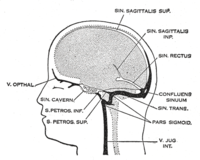
Photo from wikipedia
OBJECTIVE To explore the change of coagulation function and associated potential mechanisms and the relationship between coagulation disorders and deep venous thrombosis (DVT) after subarachnoid hemorrhage (SAH) within 3 days… Click to show full abstract
OBJECTIVE To explore the change of coagulation function and associated potential mechanisms and the relationship between coagulation disorders and deep venous thrombosis (DVT) after subarachnoid hemorrhage (SAH) within 3 days of onset. METHODS A total of 150 patients with SAH within 3 days of onset and 100 healthy individuals were recruited. Thrombelastography analysis and traditional laboratory tests were performed. Tissue factor (TF), tissue factor pathway inhibitor (TFPI) and activated protein C (APC) were tested by using enzyme-linked immunoassay kits. Extremities of patients with SAH were scanned by Doppler ultrasonography. Subgroup analysis was performed in patients with SAH based on the presence or lack of DVT. RESULTS Compared with control groups, R (an indicator of coagulation factor function in thrombelastography) was significantly decreased (4.32 ± 0.99 minutes vs. 6.00 ± 0.75 minutes; P < 0.001), especially in patients with DVT. TF was significantly increased (20.84 ± 4.15 pg/mL vs. 5.24 ± 1.86 pg/mL; P < 0.001). TFPI was decreased (50.42 ± 5.81 ng/mL vs. 64.10 ± 6.04 ng/mL). APC had no apparent changes. R was negatively correlated with TF (r = 0.358; P < 0.05) and positively correlated with TFPI (r = 0.325; P < 0.05) and APC (r = 0.162; P < 0.05). TF, TFPI, and APC had the same variation characteristics in the DVT subgroup compared with the no DVT subgroup. DVT was associated with R through association analysis (r = 0.369; P < 0.05). The R cutoff value for estimating the presence of DVT was 3.65 minutes. CONCLUSIONS Coagulation factor hyperfunction may be mainly accompanied within 3 days of SAH onset and may induce DVT. This situation may be associated with TF-TFPI-APC imbalance. R = 3.65 minutes was a potential intervention point to prevent the risk of DVT in this population.
Journal Title: World neurosurgery
Year Published: 2018
Link to full text (if available)
Share on Social Media: Sign Up to like & get
recommendations!